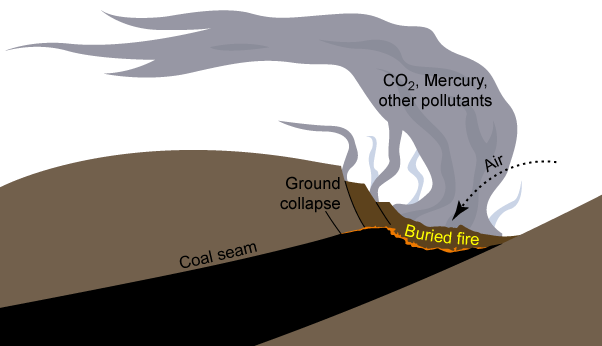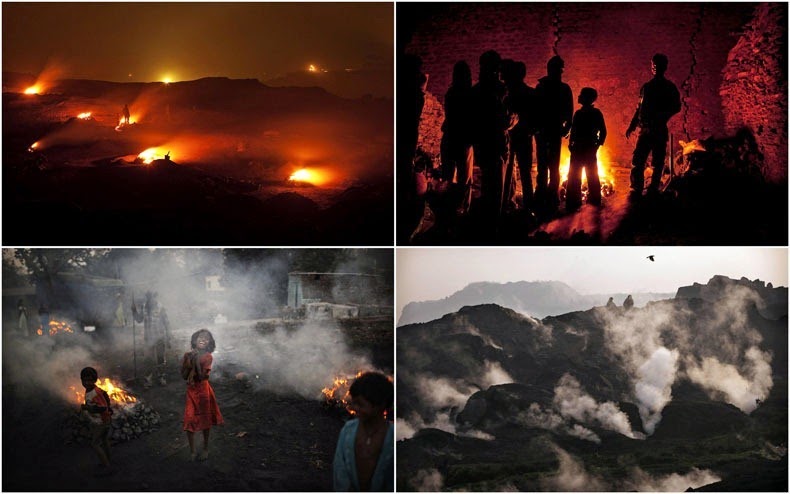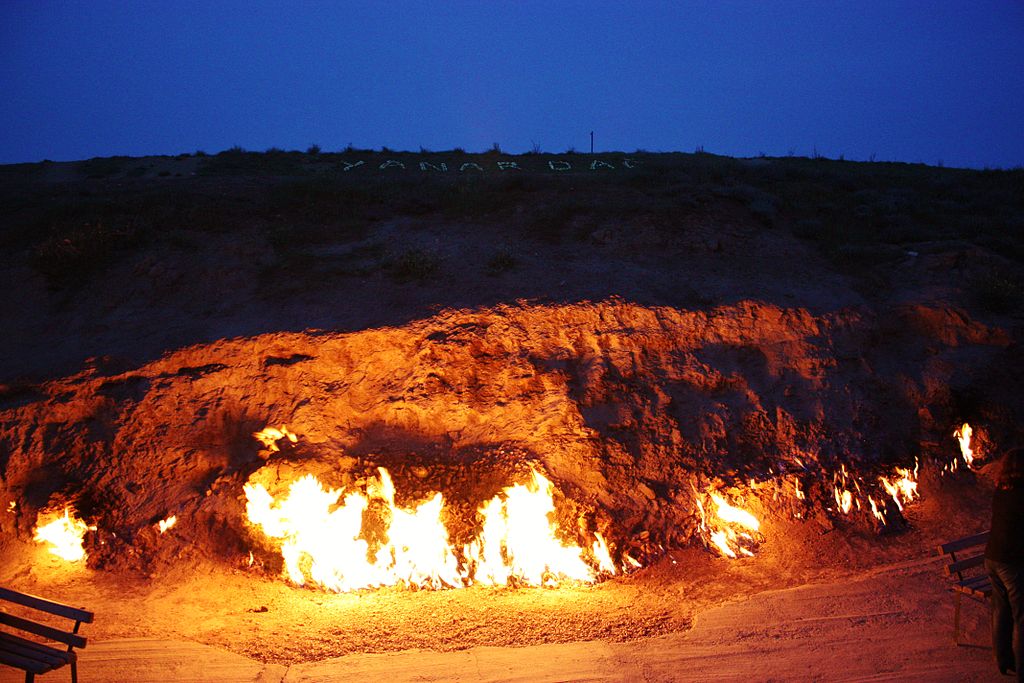A coal-seam fire is a burning of an outcrop or underground coal seam. A coal seam is a dark brown or black banded deposit of coal that is visible within layers of rock. These seams are located underground and can be mined using either deep mining or strip mining techniques depending on their proximity to the surface.
In India, as of 2010, 68 fires were burning beneath a 58-square-mile (150 km2) region of the Jharia, coalfield in Dhanbad, Jharkhand. Mine fires started in this region in 1916 and are rapidly destroying the only source of prime coking coal in the country.
Most coal-seam fires exhibit smoldering combustion, particularly underground coal-seam fires, because of limited atmospheric oxygen availability. Coal-seam fire instances on Earth date back several million years. Due to thermal insulation and the avoidance of rain/snow extinguishment by the crust, underground coal-seam fires are the most persistent fires on Earth and can burn for thousands of years, like Burning Mountain in Australia. Coal-seam fires can be ignited by self-heating of low-temperature oxidation, lightning, wildfires and even arson. Coal-seam fires have been slowly shaping the lithosphere and changing atmosphere, but this pace has become fast and extensive at modern times, triggered by enormous mining activities.
Coal fires are a serious health and safety hazard, affecting the environment by releasing toxic fumes, reigniting grass, brush, or forest fires, and causing subsidence of surface infrastructure such as roads, pipelines, electric lines, bridge supports, buildings, and homes. Whether started by humans or by natural causes, coal seam fires continue to burn for decades or even centuries until either the fuel source is exhausted, a permanent groundwater table is encountered, the depth of the burn becomes greater than the ground’s capacity to subside and vent, or humans intervene. Because they burn underground, coal seam fires are extremely difficult and costly to extinguish and are unlikely to be suppressed by rainfall. There are strong similarities between coal fires and peat fires.
What Is Its Origin?
Coal seam fires can be divided into near-surface fires, in which seams extend to the surface and the oxygen required for their ignition comes from the atmosphere, and fires in deep underground mines, where the oxygen comes from ventilation.
Mine fires may begin as a result of an industrial accident, generally involving a gas explosion. Historically, some mine fires were started when bootleg mining was stopped by authorities, usually by blowing the mine up.

Two basic factors determine whether spontaneous combustion occurs or not, the ambient temperature and the grain size:
- The higher the ambient temperature, the more quickly the oxidation reactions proceed.
- The grain size and structure determine its surface area. Kinetics will be limited by availability of reactant, which in this case is carbon exposed to oxygen.
Globally, thousands of inextinguishable mine fires are burning, especially in China where poverty, lack of government regulations and runaway development combine to create an environmental disaster. Modern strip mining exposes smoldering coal seams to the air, revitalizing the flames.
How To Detect It?
Underground coal mines can be equipped with permanently installed sensor systems. These relay pressure, temperature, airflow and gas composition measurements to the safety monitoring personnel, giving them early warning of any problems. Besides studying the geographic, geologic and infrastructural context, information can be gained from direct measurements. These include:
- Temperature measurements of the land surface, in fissures and boreholes, for example using pyrometers.
- Gas measurements to characterize the fire ventilation system (amount and velocity) and the gas composition so that the combustion reactions can be described.
- Geophysical measurements on the ground and from airplanes and helicopters to establish the extent of conductivity or other underground parameters. For example, conductivity measurements map humidity changes near the fire; measuring the magnetism can determine changes in the magnetic characteristics of the adjacent rock caused by heat.
- Remote sensing from aircraft and satellites. High-resolution optical mapping, thermal imaging and hyperspectral data play a role. Underground coal fires of several hundred to over a thousand degrees Celsius may raise the surface temperature by only a few degrees. This order of magnitude is similar to the temperature difference between the sunlit and shadowed slopes of a slag heap or sand dune. Infrared detecting equipment is able to track the fire’s location as the fire heats the ground on all sides of it. However, remote sensing techniques are unable to distinguish individual fires burning near one another and often lead to undercounting of actual fires. They may also have some difficulties distinguishing coal seam fires from forest fires. Combining in-situ data with remote sensing data does allow for monitoring of coal fire intensity over longer periods of time using time-series analyses.
What Is Its Impact On Environment?
Besides destruction of the affected areas, coal fires often emit toxic gases, including carbon monoxide and sulfur dioxide. China’s coal fires, which consume an estimated 20 – 200 million tons of coal a year, make up as much as 1 percent of the global carbon dioxide emissions from fossil fuels.
One of the most visible changes will be the effect of subsidence upon the landscape. Another local environmental effect can include the presence of plants or animals that are aided by the coal fire. The prevalence of otherwise non-native plants can depend upon the fire’s duration and the size of the affected area.
What Is The Method To Extinguish It?
In order to thrive, a fire requires fuel, oxygen, and heat. As underground fires are very difficult to reach directly, firefighting involves finding an appropriate methodology which addresses the interaction of fuel and oxygen for the specific fire in question. A fire can be isolated from its fuel source, for example through firebreaks or fireproof barriers. Many fires, particularly those on steep slopes, can be completely excavated. In the case of near-surface coal seam fires, the influx of oxygen in the air can be interrupted by covering the area or installing gas-tight barriers. Another possibility is to hinder the outflow of combustion gases so that the fire is quenched by its own exhaust fumes. Energy can be removed by cooling, usually by injecting large amounts of water. However, if any remaining dry coal absorbs water, the resulting heat of absorption can lead to re-ignition of a once-quenched fire as the area dries. Accordingly, more energy must be removed than the fire generates. In practice these methods are combined, and each case depends on the resources available. This is especially true for water, for example in arid regions, and for covering material, such as loess or clay, to prevent contact with the atmosphere.
Extinguishing underground coal fires, which sometimes exceed temperatures of 540 °C (1,000 °F), is both highly dangerous and very expensive.
Near-surface coal seam fires are routinely extinguished in China following a standard method basically consisting of the following phases:
- Smoothing the surface above the fire with heavy equipment to make it fit for traffic.
- Drilling holes in the fire zone about 20 m apart down to the source of the fire, following a regular grid.
- Injecting water or mud in the boreholes long term, usually 1 to 2 years.
- Covering the entire area with an impermeable layer about 1 m thick, e.g., of loess.
- Planting vegetation to the extent the climate allows.
A jet engine unit, known as Gorniczy Agregat Gasniczy (GAG), was developed in Poland and successfully used for fighting coal fires and displacing firedamp in mines.
Countries Experiencing It:

Some of the more notable mine fires around the world are being experienced in countries like Australia, Canada, China, Germany, India, Indonesia, New Zealand, Norway, South Africa, United States etc.








More Stories
Indian Air Force Day: Everything You Need To Know
Earth Day: Date, History, Significance Of The Most Important Day
Jallianwala Bagh Massacre: Everything You Need To Know